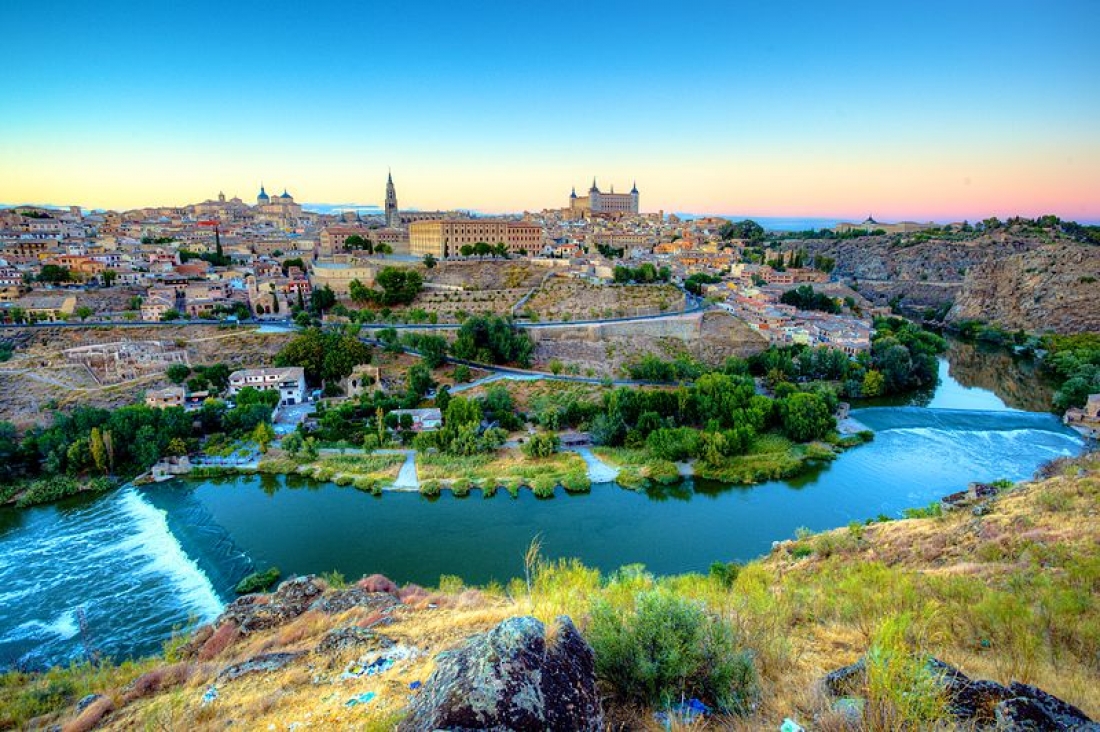If you plan to travel to Spain as part of an upcoming European holiday, hopefully you will take some time out of your busy travel schedule to visit the beautiful city of Toledo. Located in the heart of Spain, approximately 43 miles (70 kilometers) south of Madrid, Toledo is the capital of the Autonomous Community of Castile-La Mancha, and also the capital of the province of Toledo. It has a population of roughly 83,000 inhabitants and a total area of nearly 145 square miles (232 square kilometers).
History and Culture
The city of Toledo has a long and storied history, with records showing inhabitants living in the region as early as the Bronze Age. During Roman times it grew in significance as the primary commercial and governmental center in the Roman province of Cartaginesis, and following the demise of the Roman Empire, it served as the capital city of Visigothic, Spain, beginning with Liuvigild (Leovigild), and was the capital of Spain until the Moors conquered Iberia in the 8th century.
Early in the 11th century, under the direction of Alfonso VI of Castile, Toledo was conquered by Christian forces, and during most of the 16th century, it flourished as the capital city of Castile. Not long after, however, the Spanish court was moved, first to Valladolid and then to Madrid, thus causing the city’s importance to wane until the late 20th century, when it became the capital of the Autonomous Community of Castile-La Mancha.
To fully appreciate the history and culture of Toledo it is absolutely necessary to explore the topics of religion and diversity. As far back as Roman times, Toledo had been a “melting pot” of people of various faiths, who, for the most part, interacted without incident. Under Visigoth rule, however, from the 5th century through the early 8th century, people of Jewish faith living in Toledo began to be perpetually persecuted for their beliefs. This would continue until the Middle Ages and the Christian conquest of the city, when, in a quite ironic twist, Toledo once again became renowned as a city of great religious tolerance, a place where large communities of Muslims, Jews and Christians lived in relative harmony with each other. Because of this diversity, the city became a major cultural center in the 13th century, under the guidance of King Alfonso X, known familiarly as El Sabio, or “The Wise,” for his love of learning. It was during this time that Toledo’s Escuela de Traductores (School of Translators) was founded by the Archbishop Raymond of Toledo. This “tag-team” translation center, in which books written in Arabic and Hebrew were translated into Spanish by Muslim and Jewish scholars, and books written in Spanish were translated into Latin by Castilian scholars, brought enormous stores of knowledge to Europe through its back-and-forth rendering of great academic and philosophical works. The Palacio de Galiana, a structure built in the Mudéjar style of architecture, once housed one of these translation centers, and is just one of the monuments that remain today from that very important period in Spanish history.
Although the Jews and Muslims were eventually expelled from Spain in the late 15th and early 16th century respectively, there remain in Toledo a number of important monuments that together serve to honor the city’s culture and tradition of religious tolerance. These include the Synagogue of Santa Maria la Blanca, the Synagogue of El Transito, the Mosque of Cristo de la Luz and the Church of San Sebastian, all of which predate the expulsion of Jews and Muslims and all in good condition today.
Sites to See
If you plan to travel to Toledo, there are a number of must-see sites to check out while you’re there. Some of these include:
- Alcazar Fortress. Built in the 16th century, the Alcazar, as it is known locally, is located in the highest part of Toledo, overlooking the city. Since 2009 it has been home to the city’s Army Museum.
- Puerta de Bisagra and Puerta de Bisagra Nueva. The Puerta de Bisagra, which still remains today, was the main entrance to Toledo during Andalusian times and the Puerta de Bisagra Nueva is the “new” entry point and the face of the city.
- Catedral Primada. Another focal point of Toledo’s skyline is the 13th century Catedral Primada. Built in the Gothic style, this truly impressive cathedral rises 146 feet (44.5 meters) above the city, and houses, among other treasures, the Clear from Narciso Tomb, in Baroque.
- Ermita del Cristo de la Vega. The Ermita or “Hermitage” del Cristo de la Vega was built in the 11th century in the Mudéjar style of architecture.
- Alcántara Bridge. Built in Roman times, the Alcántara Bridge spans across the wide Tagus River below.
Holidays and Traditions
Finally, among the many holidays and traditions celebrated in Toledo, the most important, after Christmas and Easter of course, are the feasts of Corpus Christi, celebrating the tradition and belief in the body and blood of Jesus Christ and his Real Presence in the Eucharist—the greatest day in Toledo’s religious calendar; the Virgen del Valle, a May 1st celebration highlighted by a pilgrimage to the Ermita de la Virgen Valle; the Virgen del Sagrario, celebrated on August 15th with a traditional procession inside the Cathedral, in which participants carry out the symbolic drinking of water of the Virgin in jars; San Ildefonso, held on January 23 in honor of San Ildefonso, a saint and once a Toledo Visigoth bishop; and San Leocadia, celebrated on December 9th each year, in honor of the virgin and martyr of Roman Hispania.



